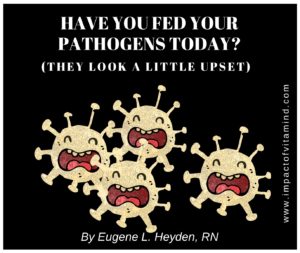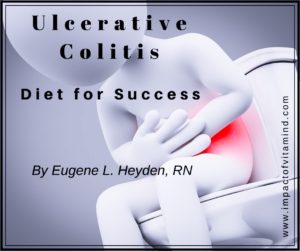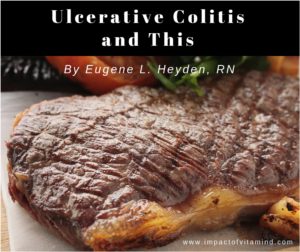Crohn’s Disease: Finding a Way Out Japanese Style

Last update: 12-05-23
By Eugene L. Heyden, RN
Here I will introduce you to a diet just made for Crohn’s, and it was designed by a team of gastroenterologists. (Can’t beat that!) The diet is very successful. And I mean very successful. It can help induce remission. It can help maintain remission. You can turn back time. You get your life back! It is called The Semi-Vegetarian Diet. Let’s take a look.
“Accumulating evidence indicates that excess of unabsorbed iron that enters the colon lumen causes unwanted side effects at the intestinal host-microbiota interface.
“Notably, accumulating evidence suggests that unabsorbed iron can stimulate growth and virulence of bacterial pathogens in the intestinal environment.” (Kortman et al., 2014)
In my book on Crohn’s, I spend a great deal of time warning of the dangers of iron, and how its excess—so commonplace in our society—leads to disease. No one else seems to be telling you this, so I guess it’s up to me. And yes, this is still an article on diet, but you need to learn one important reason why, in my opinion, The Semi-Vegetarian Diet is so effective. Do me a favor. Read again the two quotes placed above, then skip down and read the following two quotations:
“In the colonic lumen, large amounts of iron are regularly present, mostly constituted by excess dietary iron not absorbed in the duodenum (the major site of iron absorption). This is illustrated by the high concentration of iron found in feces of British adults on a standard Western diet and in weaning infants fed with complementary solid foods.” (Kortman et al., 2014, emphasis added)
“Besides the effects or iron on the gut microbiota, which may cause a shift towards a more pathogenic profile and an increase in virulence of enteric pathogens, iron may also directly exert unfavorable effects on the gut epithelium most likely by the promotion of redox stress.” (Kortman et al., 2014, emphasis added)
Clearly, clearly, iron ingested in excess of your capacity to absorb it—in excess of what you can appropriately utilize—can harm you. It can only make your Crohn’s worse (if that’s possible). Anyone who wishes to find a way out, Japanese style, should probably be very careful to limit iron intake in excess of their need.
Now, with that out of the way, keeping the dangers of iron clearly in mind, let’s take a look at the diet especially designed for the patient with Crohn’s. What follows is based on a chapter entitled “A diet to withhold,” from More to Consider in The Battle Against Crohn’s.
The Semi-Vegetarian Diet
The Semi-Vegetarian Diet for Crohn’s was first introduced to medicine in 2010 in a paper written by a team of Japanese gastroenterologists (Chiba et al), but this diet has been around, like, forever. In the not-too-distant past, we ate vegetation when we were not eating fish (or insects). We felt lucky if we found a beast to eat. But then the Western diet appeared on the scene, and now we can eat a beast three times a day and think nothing of it. But there is a problem: “diets rich in animal protein and animal fat cause a decrease in beneficial bacteria in the intestine.” (Chiba et al., 2010) Given the realization that a decrease in beneficial bacteria, allowing an increase of pathogenic bacteria and giving rise to dysbiosis, is of no benefit for the patient with Crohn’s, it was only a matter of time before someone in the medical community designed a diet to address this problem, a diet particularly designed for the patient with Crohn’s . . . and it worked! Why did it work?
“Diets rich in animal protein [therefore, rich in iron] and animal fat cause a decrease in beneficial bacteria in the intestine. . . . we regard IBD as a lifestyle-related disease that is mediated by mainly a westernized diet.
“Therefore, we designed a diet that hopefully increases the number of beneficial bacteria. Limited foods are known to increase beneficial bacteria; green tea and unrefined brown rice. However, most prebiotics are extracts from plants. Therefore we thought that a vegetarian diet would be suitable for IBD. Considering that excessive restriction of foods can be less acceptable, a semi vegetarian diet (SVD) has been provided to IBD patients in our hospital since 2003. SVD, which is rich in dietary fiber, is quite opposite to conventional low-residue diets in IBD.” (Chiba et al., 2010)
Did I mention it worked? In the study by Chiba et al, the remission rate was “100% at one year and 92% at two years.” I would say this diet worked! To be fair, this study also involved an initial period of controlled fasting, in addition to the use of infliximab (Remicade)—3 infusions over a 6-week period. The success rate of conventional therapy alone is probably nowhere near this level. For Remicade there is about a 39% remission rate at 12 weeks (Chamberlin et al., 2011) (I could not find data for remission rates at one and two years)—so The Semi-Vegetarian Diet is, indeed, impressive! And it certainly makes conventional drug therapy look good. (It needs all the help it can get.)
“The SVD was highly effective in preventing relapse in CD. Remission rate with SVD was 100% at 1 year and 92% at 2 years. This is the best result in relapse prevention. The concentration of C- reactive protein, an indicator of inflammation, was normal at the final visit in more than half of the patients on the SVD, which indicates that more than half of the patients who continue the SVD diet will be free from relapse as long as they maintain the diet.” (Chiba et al., 2010)
When I first read about this diet, it didn’t take long for me to realize what was going on here. Not only does this diet target dysbiosis by reducing exposure to animal fat and protein, but this diet is also a diet low in iron. It is the ultimate iron-withholding diet. It allows the intake of enough iron, periodically, but not an excess of iron that would accumulate in the bowel to any great extent, contribute to dysbiosis, and irritate the inflamed portions of the bowel. Unlike the Western diet, a diet that doesn’t give a hoot about the damage caused by large amounts of iron that cannot be absorbed, The Semi-Vegetarian Diet cares, for it is a low-in-iron diet. I would suggest that it remain a low-in-iron diet or you can kiss its rewards goodbye.
Ironically, The Semi-Vegetarian Diet will need to be “Westernized” a little, for you are not all into miso (fermented bean paste) or algae, food items familiar in Japanese culture. You are more familiar with M&M’s, Twinkies, and SpaghettiOs. I’ll bet we can easily modify The Semi-Vegetarian Diet to include things you are a little more familiar with. Along this line, we’ll now discuss the food pyramid associated with the diet.
At the tip-top portion of the pyramid is meat. You are allowed a limited amount meat, once every 2 weeks. (Yes, you can do this.) The next portion of the pyramid allows a limited portion of fish once a week—easy! The rest of the pyramid is fairly straightforward. It includes milk, eggs, yogurt, fruits, vegetables, brown rice, legumes (beans), and potatoes. It is basically a lacto-ovo-vegetarian diet, with a little meat thrown in, in order to satisfy the needs of the carnivore within. Of course, there are other restrictions:
“Foods that have been shown to be a risk factor for IBD in or outside Japan including sweets, bread, cheese, margarine, fast foods, carbonated beverages, and juices, were discouraged. Healthy habits were encouraged; no smoking, regular physical activity, moderate to no use of alcohol, regularity of meals, and not eating between meals.” (Chiba et al., 2010)
Admittedly, this diet (and lifestyle constraints), seems harsh and not doable, but it is not that bad—particularly when you consider that Crohn’s is harsh and not doable and bad. Actually, many, many people in your community willingly choose the lacto-ovo-vegetarian diet. Seventh-day Adventists generally practice this diet and do a lot better than the rest of us when it comes to health issues. Learn from them (or become one of them). That being said, they are probably not particularly careful with respect to iron. But you need to be! Teach them a lesson or two.
In the spirit of The Semi-Vegetarian Diet, here are the rules: Follow a lacto-ovo-vegetarian diet, choosing foods more easily found in our culture and foods not fortified with iron. Occasionally—very occasionally—allow yourself a little meat (maybe no meat at all—you’re lovin’ the casseroles!). Limit the use of sweets, bread, cheese, etc. as mentioned above. Make healthy lifestyle choices, as per above. Fast foods and iron-fortified convenience foods are to be avoided within reason. This diet is very doable. You eat meat . . . rarely. You eat wholesome plant-based foods at every meal, trying your best to avoid the foods that are fortified with iron. You live a wholesome life. You limit the foods that are known to be a risk factor for Crohn’s. How good does remission sound? You can do this! If needed, enlist the services of a dietitian to design a diet plan especially for you, designed around the principles discussed in this post. Make sure to find one who knows of the dangers of iron intake in excess of what the body can absorb and utilize. When embarking on a diet makeover, be sure attention is paid to the sulfites, microparticles, emulsifiers, etc.—all food additives one may want to limit, all food items that create challenges to the tissues and immune system of the gut. My book will explain.
Related articles (Click on image to open)
References
Chiba M, Abe T, Tsuda H, Sugawara T, Tsuda S, Tozawa H, Fujiwara K, Imai H 2010 Lifestyle-Related Disease in Crohn’s Disease: Relapse Prevention by a Semi-Vegetarian Diet. World J Gastroenterol; May 28; 28:16(20):2484–2495
Kortman G AM, Raffatellu M, Swinkels DW, Tjalsma H 2014 Nutritional Iron Turned Inside Out: Intestinal Stress from a Gut Microbial Perspective. FEMS Microbial Rev 38:1202–1234
Further reading
Chiba et al 2014 Plant-Based Diets in Crohn’s Disease. Perm J, Fall; 18(4):94
Copyright © 2016–2023 Eugene L. Heyden, RN
All Rights Reserved




